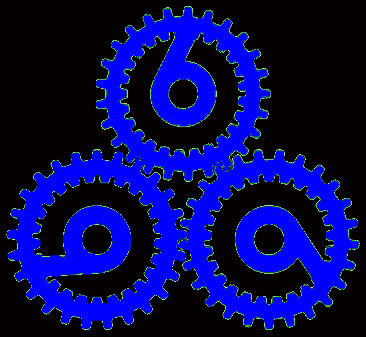(Part 1 is here.)
“Why don’t you be like me?
Why don’t you stop and see?
Why don’t you hate who I hate, kill who I kill to be free?”
-The Monkees, Randy Scouse Git
Last time, I was talking about how pop-culture aspects are a viable source of inspiration, or even workable as a basis, for one’s personality. I also mentioned that sometimes this can go very wrong indeed.
Here’s an example.
Around British SF fandom in the 80s, there was a person who was known (behind her back – fandom, like any group, has its’ cliques and bitching) as Ratwoman. She was called this because of her hobby of keeping rats as pets. Now I’m not going to gainsay that as a hobby – I’ve kept fancy rats myself and found them amiable companions – but she kept (so the story went) over fifty of the buggers and let them run all over her house, with the attendant hygiene issues that implies.
Ratwoman was also, like many in the scene, an enthusiastic participant of the occult/pagan fringe of fandom. Her preferred mythos was Pern – the realm of telepathically-bonded dragon-riding heroes in the books of Anne McCaffrey. As you can imagine, Ratwoman getting to meet the author herself was quite an important moment… which she spent explaining exactly to McCaffrey what the books had got wrong about Pern, on the basis that Ratwoman had been there and knew better.
I’ve written about Otherkin before, and it’s a position I’ve a lot of sympathy with. I certainly understand from my own experiences the feeling of being so very different from everyone else around you that you really don’t feel, or want to be, human. Around the same time as the Ratwoman story, I was involved with a group of people in fandom who, before the term Otherkin was even coined, identified as being the reincarnation of Tolkienesque elves. (I wasn’t an elf. I had a whole blurry mythos of my own going on at the time, part-Lovecraft, part-Illuminatus. But we got on.) It’s a compelling feeling, that combination of outsider and tribe-member. So I completely get the idea of inhabiting a myth-structure that completely. But at the same time, I can’t help but see just how fucking presumptuous it is to tell the creator of said mythos, “You’re Doing It Wrong”.
(Now, if we want to get picky, the possibility that Ratwoman was right has to be mentioned… anyone who’s familiar with Alan Moore’s theory of Ideaspace could raise the possibility that there is a Ur-Pern out there in the imaginal realm, and that some folk could conceivably make contact with it. Or even that Pern, faults and all, truly does physically exist somewhere in deep space and she actually did pick up some telepathic vibe coming from it, or even translated her soul there in some manner. Nonetheless; if nothing else, going up to the person who is pretty sure they actually invented that world with overriding declarations of your version of their reality is, at the very least, impolite and tacky.)
I mentioned before that fannish excesses of this type, roleplay in every sense, can provide a useful place to experiment with the tenets of our personalities – and even in the face of such extreme examples as above, I believe that’s a useful and rewarding thing. But a necessary stage of that process is that sometimes, you have to leave the scenario. You have to step away. Or your personality becomes subsumed by the role.
It’s a particular problem for occultists. At some level, practicing magic is the assumption that your imagination can directly shape the universe. The problem there is that, if you don’t constantly cross-check what goes on inside your head with what goes on outside it, you’ll fall into the trap of what I call mageitis – spinning exquisite worlds in your mind of which you are the absolute ruler, while living in your mum’s basement covered in fast-food stains, B.O. and ennui. This is difficult enough for anyone – neurologically, we’re hard-wired to treat metaphor as very close to reality – so unless you work hard at this, the possibility of being swallowed by the fiction is constant.
(Somebody once tried to gently question Ratwoman’s view of reality. She responded angrily that the person was so negative that they had “a grey psychic cloud the size of Moscow” over their head. Another danger of mageitis is hyperbole.)
Actors have known this for a long time. Examples of the performer being absorbed by the role abound – Jeremy Brett’s tragic battle with the Sherlock Holmes archetype is an especially sad one. The smart performers develop a balance, either a Method-based give-and-take of being completely in character and then fading back to themselves, or (mostly) never forgetting that it’s just acting, luvvy. But when you’re actively trying to build or rebuild your personality around such a basis… what do you do?
All personality has a performative aspect to it. Sometimes, all of us feel like the mere act of being ourselves is just too much bloody work. But I can’t help thinking that to just copy an entire personality-type, or character, or mythos from another – be it fact or fiction – is just plain lazy. I suspect a lot of that is an attempt to paper over perceived or actual flaws in one’s personality, bridging a gap between what you are and what you’re told you should be. It’s really easy to just pull on a costume, a fiction-suit, and call it good-enough.
Maybe it would have been easier if I’d just done that. But the cracks and flaws, the bits that didn’t fit, were either too big or the wrong shape.
And, I was increasingly suspecting, maybe those cracks and flaws actually had a purpose.
To be concluded…


